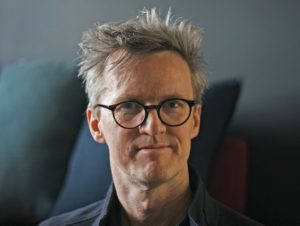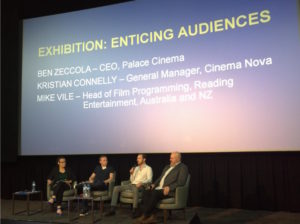The screen industry needs to stop cutting writers’ fees and to do a lot better in providing career paths for writers, according to Guesswork Television MD Kevin Whyte.
Chiming with the concerns of the Australian Writers’ Guild and CJZ executives Nick Murray and Matt Campbell, Whyte tells IF: “Working out how we can make Australia an attractive and lucrative place to be a television writer, which means we put stories and ideas first and foremost, is critically important.
“The struggling artist cliché is wearing a bit thin. The industry should focus on creating career paths, not just so people stay but to entice people in into the industry.
“I am not saying there is an easy solution but as our budgets come under more and more pressure it’s often the creatives whose fees are cut. Often they put their hands up to take $10,000 out of their pay packet if it gets their project over the line. We need to not let them; that should be out of bounds. If we continue to save money on writers that is at our peril.”
The company had such a hectic production schedule when Todd Abbott joined last March as director of programs and development he could not devote as much time as he wanted to his primary goal: driving development.
Home to Hannah Gadsby’s Nanette, Get Krack!n’, Hard Quiz, Corey White’s Roadmap to Paradise, The Edge of the Bush and The Weekly with Charlie Pickering, Guesswork was named 2018 Production Business of the Year at the Screen Producers Australia Awards; it also picked up the Comedy Series Production of the Year gong for Rosehaven, a co-production with What Horse?
So from the start of this year Abbott has been nurturing a stack of projects, some in the early workshop stage, others at or near script delivery. “Depending on how budgets pan out with networks over the next few months, hopefully that means we have a big second half of the year in terms of production,” says Abbott.
Guesswork is in the fortunate position of being able to draw on a sizable pool of talent whose careers are managed by the parent company, the Token group.
“The discussions we are having with the networks are that they are incredibly keen to develop local content, in particular comedy,” says Abbott. “Apart from the ABC, which is flying the flag with comedy, the other broadcasters are very conscious that they could be spending more time on comedy.”
The Guesswork financing model typically involves teaming up with an international partner such as SundanceTV on Rosehaven and the now defunct Pivot network on Please Like Me.

‘Get Krack!n’
Whyte is looking for a new home in the US for Get Krack!n following the closure of NBCUniversal’s Seeso network. He was especially gratified by the positive feedback to the third episode of the current series which dealt with disability.
“We are constantly talking to the international players,” says Abbott. “We have to be creative in looking for ways to fund shows.”
Whyte observes there are fewer prime-time slots available on the commercial free-to-air broadcasters given the preponderance of stripped light entertainment shows.
The Guesswork execs are delighted with Frayed, the six-part comedy-drama commissioned by the ABC and Sky UK, a co-production with Sharon Horgan and Clelia Mountford’s company Merman Television which is now in post.
Australian comedian Sarah Kendall (a Token client) created the 1989-set show in which she plays Simone Burbeck, who appears to have the perfect life with a mansion in London, husband and children. After her husband has a fatal heart attack during an encounter with a prostitute, the true state of their finances is revealed. Simone is broke, homeless and a social outcast.
With no other options and two children to care for, she is forced to return to her family home in Newcastle. It turns out Simone’s past isn’t quite the story that she told everyone in London.
The cast includes Matt Passmore, Kerry Armstrong, Diane Morgan, Ben Mingay and Robert Webb. Kendall wrote the series produced by Nicole O’Donohue and directed by Jennifer Leacey (Reckoning, Rake, Bite Club) and Shaun Wilson (Rosehaven, The Ex-PM).
Abbott says: “Nothing else like it has been on Australian television for a long time. There was a conscious decision by Sarah and Merman to make sure that for a show set in the late 1980s there was no parody of the fashions or the clichés of that era. We brought over from LA a bunch of Panavision lenses from the 1980s that had been reconfigured so they are compatible with Red digital cameras. It looks gorgeous.”

‘Rosehaven’
Season four of Hard Quiz is in production for the ABC and the company’s sales arm Guesswork Distribution is looking to sell the format internationally. Shooting will soon get underway on the fifth series of The Weekly with Charlie Pickering.
In its third series, Rosehaven continues to rank among the most popular ABC shows, which Whyte sees primarily as a tribute to the superb scripts by Luke McGregor and Celia Pacquola. Already the co-creators have started to think about storylines for series four.
Whyte is an executive producer on Everything’s Gonna Be Okay, a 10-part comedy created, written by and starring Josh Thomas. Commissioned by Disney’s young-adult US cable network Freeform and currently scripting, the show will follow Thomas as Nicholas, a neurotic 25-year-old Aussie who lives at home with his single dad and two teenage half-sisters, one of whom has autism.
When their dad becomes terminally ill, he realises the responsibility of keeping the family together falls on him. “It’s wonderful to see Josh build on Please Like Me by taking his unique vision into a new market,” Whyte says.
IF Magazine. 11 March, 2019 by Don Groves


